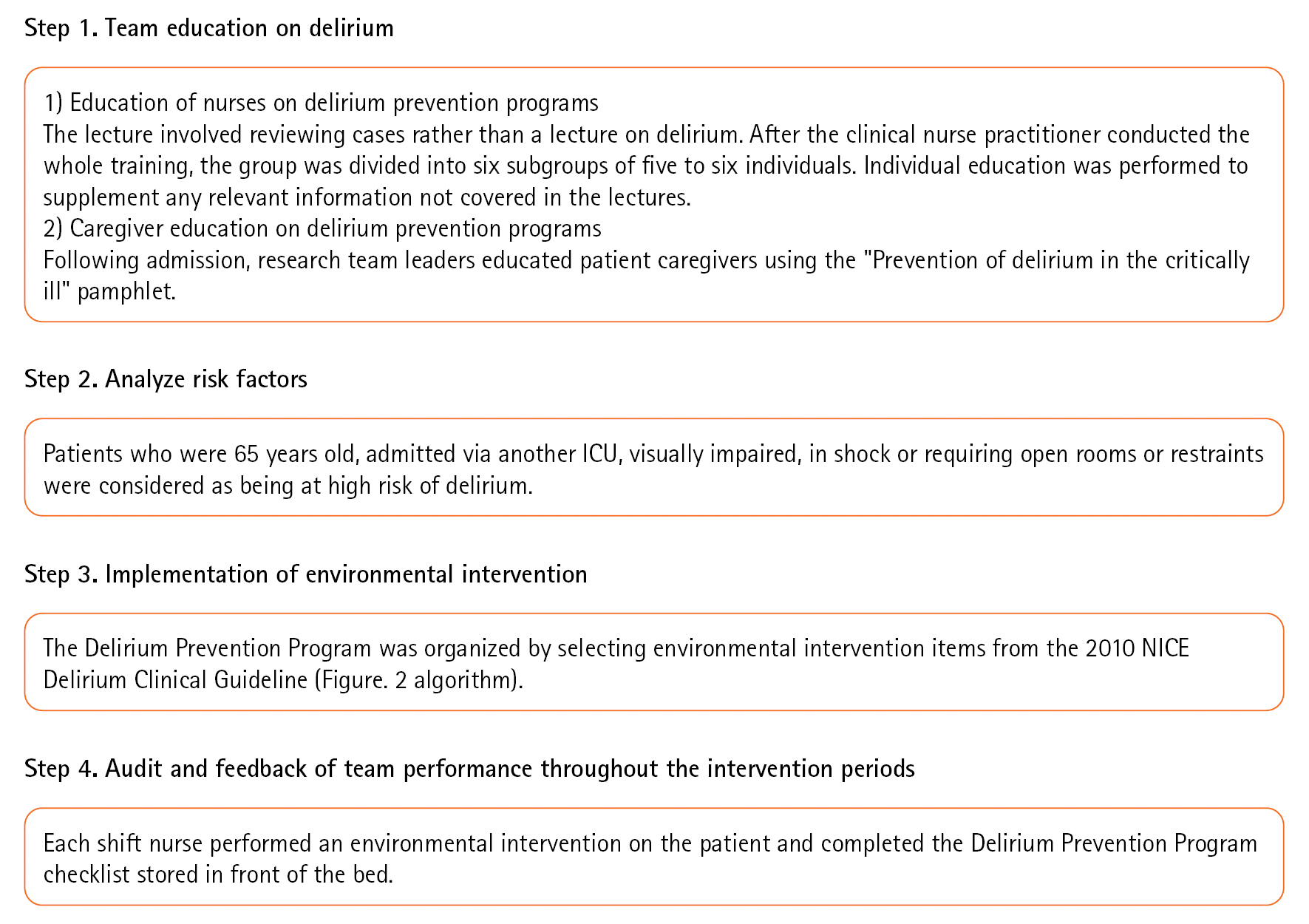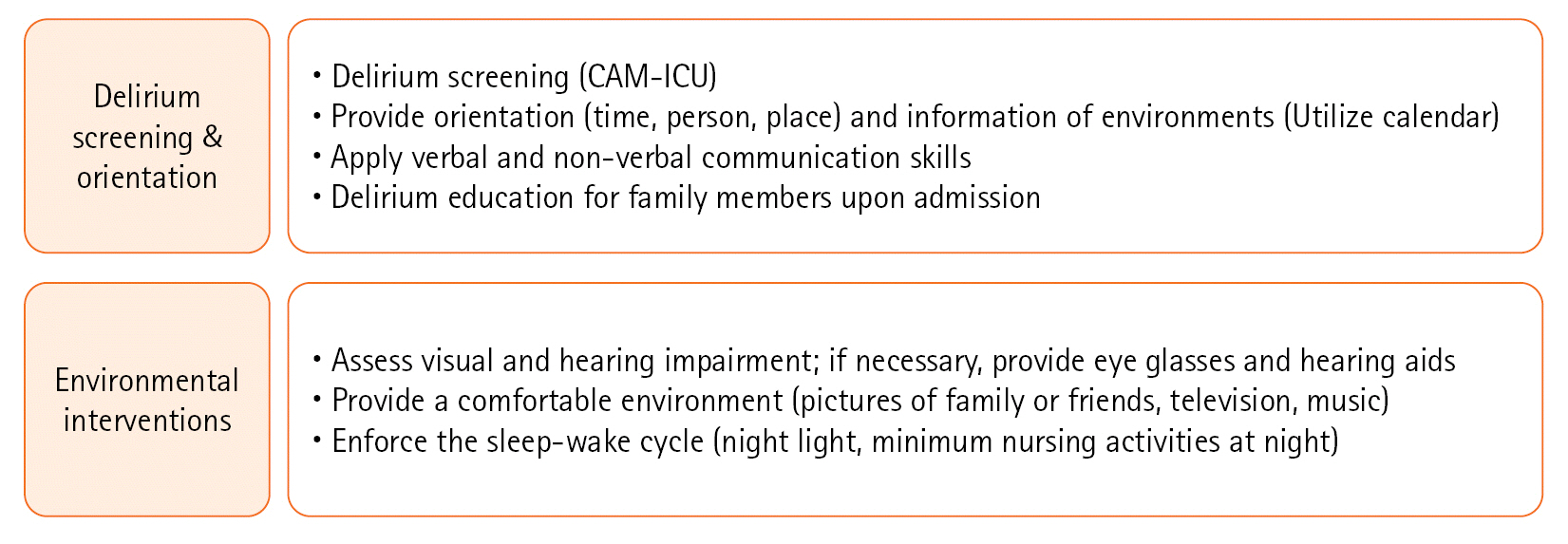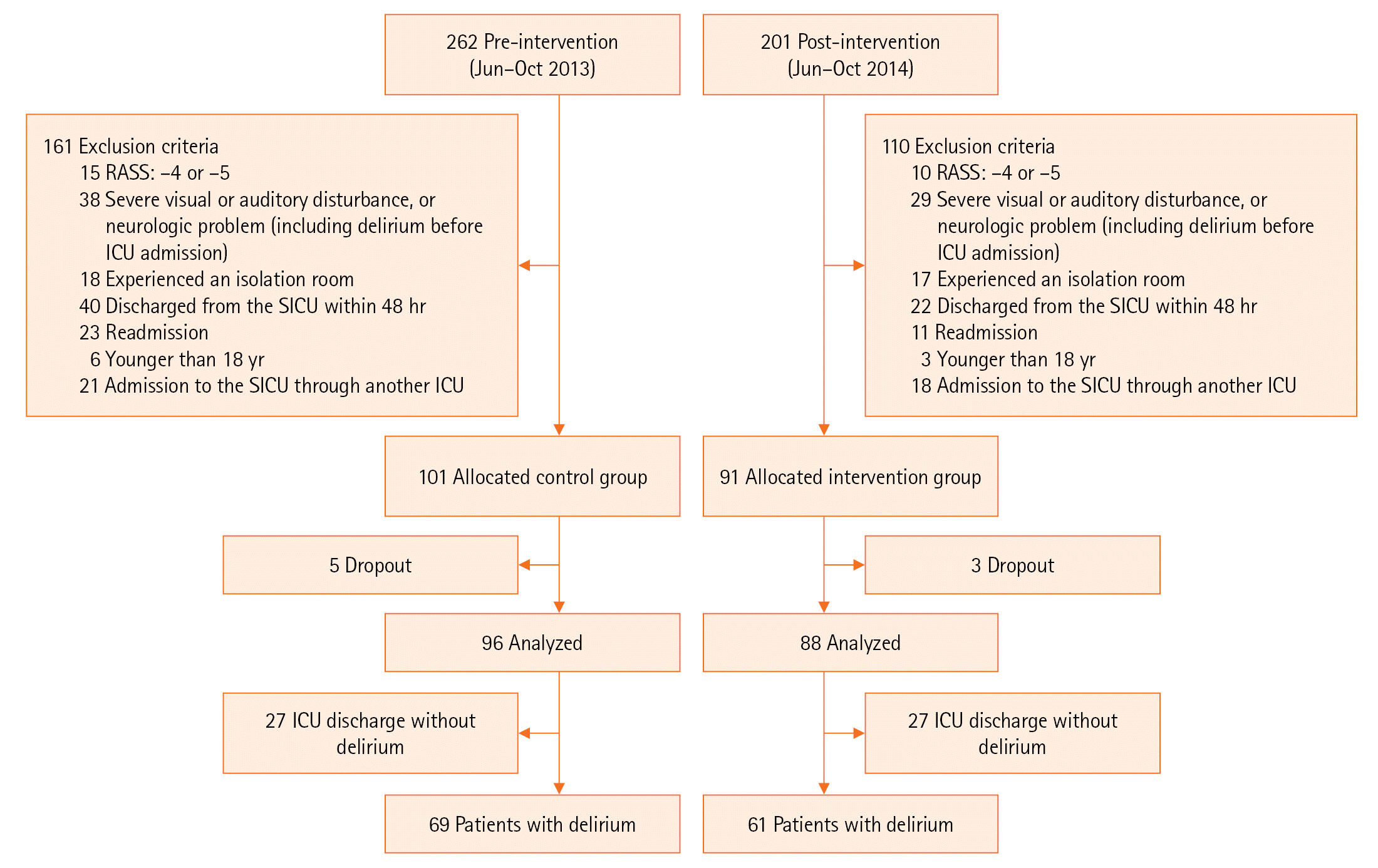Acute Crit Care.
2023 Nov;38(4):479-487. 10.4266/acc.2023.00990.
The effects of environmental interventions for delirium in critically ill surgical patients
- Affiliations
-
- 1Division of Acute Care Surgery, Department of Surgery, Asan Medical Center, University of Ulsan College of Medicine, Seoul, Korea
- 2Department of Critical Care Nursing, Asan Medical Center, University of Ulsan College of Medicine, Seoul, Korea
- 3Division of Acute Care Surgery, Department of Surgery, Korea University Guro Hospital, Seoul, Korea
- KMID: 2550904
- DOI: http://doi.org/10.4266/acc.2023.00990
Abstract
- Background
Delirium occurs at high rates among patients in intensive care units and increases the risk of morbidity and mortality. The purpose of this study was to investigate the effects of environmental interventions on delirium.
Methods
This prospective cohort study enrolled 192 patients admitted to the surgical intensive care unit (SICU) during the pre-intervention (June 2013 to October 2013) and post-intervention (June 2014 to October 2014) periods. Environmental interventions involved a cognitive assessment, an orientation, and a comfortable environment including proper sleep conditions. The primary outcomes were the prevalence, duration, and onset of delirium.
Results
There were no statistically significant differences in incidence rate, time of delirium onset, general characteristics, and mortality between the pre-intervention and post-intervention groups. The durations of delirium were 14.4±19.1 and 7.7±7.3 days in the pre-intervention and post-intervention groups, respectively, a significant reduction (P=0.027). The lengths of SICU stay were 20.0±22.9 and 12.6±8.7 days for the pre-intervention and post-intervention groups, respectively, also a significant reduction (P=0.030).
Conclusions
The implementation of an environmental intervention program reduced the duration of delirium and length of stay in the SICU for critically ill surgical patients.
Keyword
Figure
Reference
-
1. Inouye SK. The dilemma of delirium: clinical and research controversies regarding diagnosis and evaluation of delirium in hospitalized elderly medical patients. Am J Med. 1994; 97:278–88.
Article2. Fong TG, Tulebaev SR, Inouye SK. Delirium in elderly adults: diagnosis, prevention and treatment. Nat Rev Neurol. 2009; 5:210–20.
Article3. Robinson TN, Raeburn CD, Tran ZV, Angles EM, Brenner LA, Moss M. Postoperative delirium in the elderly: risk factors and outcomes. Ann Surg. 2009; 249:173–8.4. Pisani MA, McNicoll L, Inouye SK. Cognitive impairment in the intensive care unit. Clin Chest Med. 2003; 24:727–37.
Article5. Holt R, Young J, Heseltine D. Effectiveness of a multi-component intervention to reduce delirium incidence in elderly care wards. Age Ageing. 2013; 42:721–7.
Article6. O’Hanlon S, O’Regan N, Maclullich AM, Cullen W, Dunne C, Exton C, et al. Improving delirium care through early intervention: from bench to bedside to boardroom. J Neurol Neurosurg Psychiatry. 2014; 85:207–13.
Article7. Ely EW, Shintani A, Truman B, Speroff T, Gordon SM, Harrell FE Jr, et al. Delirium as a predictor of mortality in mechanically ventilated patients in the intensive care unit. JAMA. 2004; 291:1753–62.
Article8. Dammeyer JA, Mapili CD, Palleschi MT, Eagle S, Browning L, Heck K, et al. Nurse-led change: a statewide multidisciplinary collaboration targeting intensive care unit delirium. Crit Care Nurs Q. 2012; 35:2–14.9. Salluh JI, Wang H, Schneider EB, Nagaraja N, Yenokyan G, Damluji A, et al. Outcome of delirium in critically ill patients: systematic review and meta-analysis. BMJ. 2015; 350:h2538.
Article10. Inouye SK, Charpentier PA. Precipitating factors for delirium in hospitalized elderly persons. Predictive model and interrelationship with baseline vulnerability. JAMA. 1996; 275:852–7.
Article11. Arenson BG, MacDonald LA, Grocott HP, Hiebert BM, Arora RC. Effect of intensive care unit environment on in-hospital delirium after cardiac surgery. J Thorac Cardiovasc Surg. 2013; 146:172–8.
Article12. Serafim RB, Bozza FA, Soares M, do Brasil PE, Tura BR, Ely EW, et al. Pharmacologic prevention and treatment of delirium in intensive care patients: a systematic review. J Crit Care. 2015; 30:799–807.
Article13. Kang J, Lee M, Ko H, Kim S, Yun S, Jeong Y, et al. Effect of nonpharmacological interventions for the prevention of delirium in the intensive care unit: a systematic review and meta-analysis. J Crit Care. 2018; 48:372–84.
Article14. Patel J, Baldwin J, Bunting P, Laha S. The effect of a multicomponent multidisciplinary bundle of interventions on sleep and delirium in medical and surgical intensive care patients. Anaesthesia. 2014; 69:540–9.
Article15. Bounds M, Kram S, Speroni KG, Brice K, Luschinski MA, Harte S, et al. Effect of ABCDE bundle implementation on prevalence of delirium in intensive care unit patients. Am J Crit Care. 2016; 25:535–44.
Article16. Ali MA, Hashmi M, Ahmed W, Raza SA, Khan MF, Salim B. Incidence and risk factors of delirium in surgical intensive care unit. Trauma Surg Acute Care Open. 2021; 6:e000564.
Article17. Devlin JW, Skrobik Y, Gélinas C, Needham DM, Slooter AJ, Pandharipande PP, et al. Clinical practice guidelines for the prevention and management of pain, agitation/sedation, delirium, immobility, and sleep disruption in adult patients in the ICU. Crit Care Med. 2018; 46:e825–73.18. Ely EW, Inouye SK, Bernard GR, Gordon S, Francis J, May L, et al. Delirium in mechanically ventilated patients: validity and reliability of the confusion assessment method for the intensive care unit (CAM-ICU). JAMA. 2001; 286:2703–10.19. Lin SM, Liu CY, Wang CH, Lin HC, Huang CD, Huang PY, et al. The impact of delirium on the survival of mechanically ventilated patients. Crit Care Med. 2004; 32:2254–9.
Article20. Luetz A, Heymann A, Radtke FM, Chenitir C, Neuhaus U, Nachtigall I, et al. Different assessment tools for intensive care unit delirium: which score to use? Crit Care Med. 2010; 38:409–18.
Article21. Pisani MA, Kong SY, Kasl SV, Murphy TE, Araujo KL, Van Ness PH. Days of delirium are associated with 1-year mortality in an older intensive care unit population. Am J Respir Crit Care Med. 2009; 180:1092–7.
Article22. Rawal G, Yadav S, Kumar R. Post-intensive care syndrome: an overview. J Transl Int Med. 2017; 5:90–2.
Article23. Faustino TN, Suzart NA, Rabelo RN, Santos JL, Batista GS, Freitas YS, et al. Effectiveness of combined non-pharmacological interventions in the prevention of delirium in critically ill patients: a randomized clinical trial. J Crit Care. 2022; 68:114–20.
Article24. Vidán MT, Sánchez E, Alonso M, Montero B, Ortiz J, Serra JA. An intervention integrated into daily clinical practice reduces the incidence of delirium during hospitalization in elderly patients. J Am Geriatr Soc. 2009; 57:2029–36.
Article25. Björkelund KB, Hommel A, Thorngren KG, Gustafson L, Larsson S, Lundberg D. Reducing delirium in elderly patients with hip fracture: a multi-factorial intervention study. Acta Anaesthesiol Scand. 2010; 54:678–88.
Article26. Ely EW, Siegel MD, Inouye SK. Delirium in the intensive care unit: an under-recognized syndrome of organ dysfunction. Semin Respir Crit Care Med. 2001; 22:115–26.
Article27. Zaal IJ, Spruyt CF, Peelen LM, van Eijk MM, Wientjes R, Schneider MM, et al. Intensive care unit environment may affect the course of delirium. Intensive Care Med. 2013; 39:481–8.
Article28. Aurell J, Elmqvist D. Sleep in the surgical intensive care unit: continuous polygraphic recording of sleep in nine patients receiving postoperative care. Br Med J (Clin Res Ed). 1985; 290:1029–32.
Article29. Reade MC, Eastwood GM, Peck L, Bellomo R, Baldwin I. Routine use of the Confusion Assessment Method for the Intensive Care Unit (CAM-ICU) by bedside nurses may underdiagnose delirium. Crit Care Resusc. 2011; 13:217–24.
Article
- Full Text Links
- Actions
-
Cited
- CITED
-
- Close
- Share
- Similar articles
-
- Implementation and effectiveness of a delirium care protocol in Thai critically ill children
- Prevention and management of delirium in critically ill adult patients in the intensive care unit: a review based on the 2018 PADIS guidelines
- Sedation in the Critically Ill Patients
- Delirium in the intensive care unit
- Clinical Approach to Delirium in Elderly Patients




